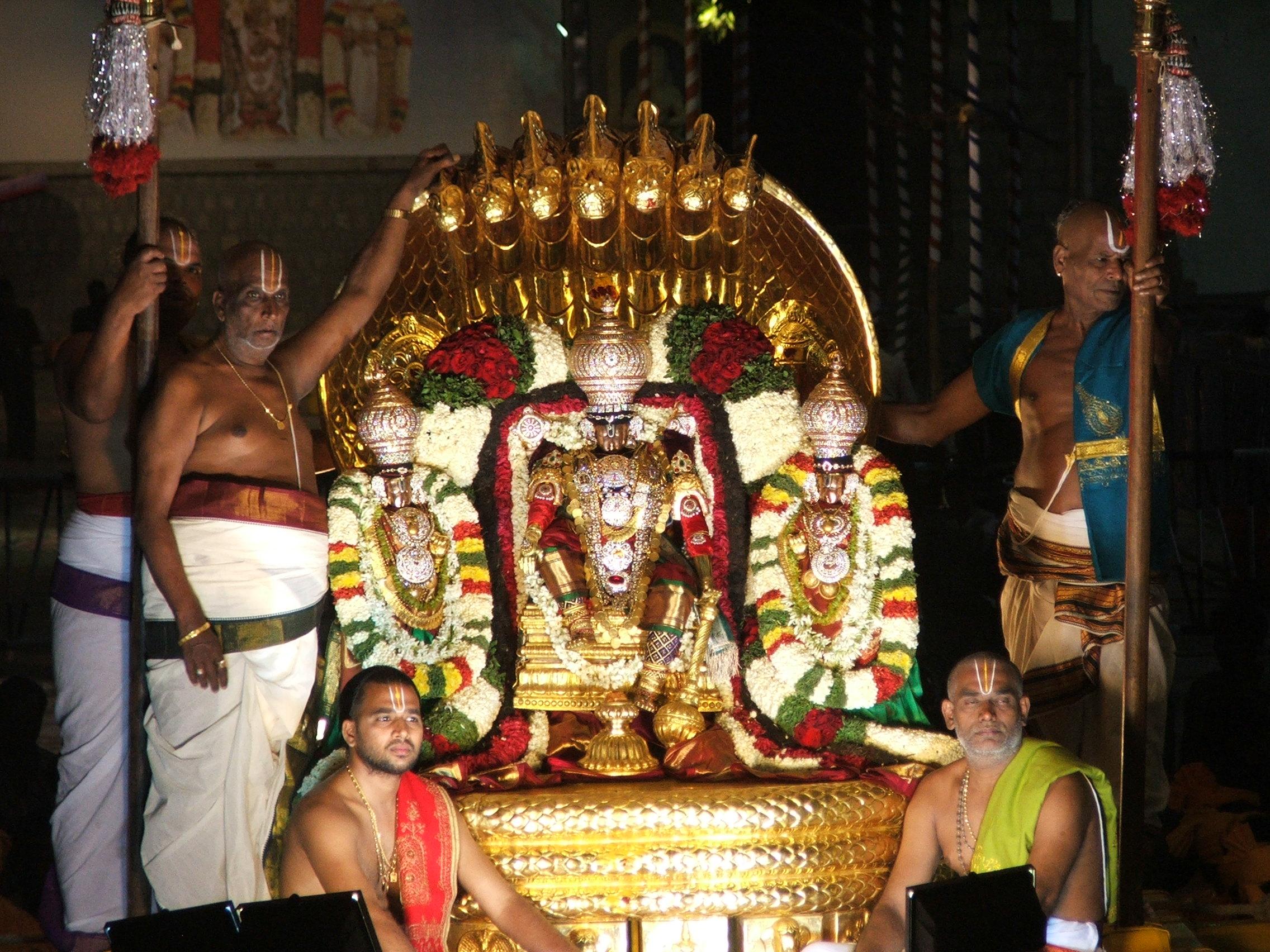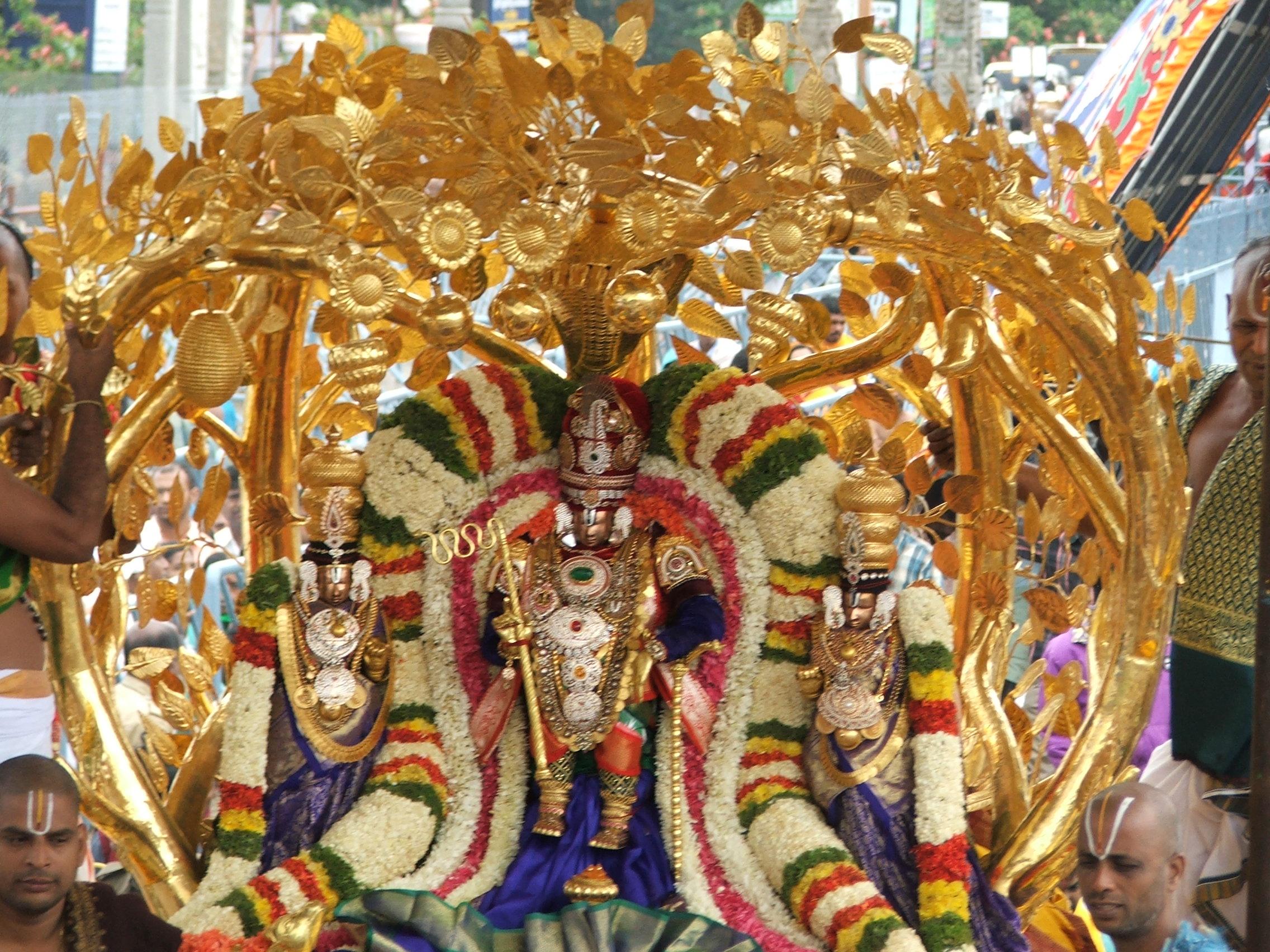|
Malayappa Swami
Malayappa Swami is the current ''utsava murti'' (procession deity) in the Tirumala Venkateswara Temple, Tirumala. Malayappa Swami is worshipped during religious ceremonies and processions wherein it would be inappropriate to use the main deity (for example one which requires the deity to be carried or moved). The two deities are worshipped equally and believed to be non-different in personality. The Malayappa deity is classed as a Swayambhu and was discovered in 1339 AD. Initial records state his original name as ''Malai Kuniya Ninra Perumal'' (Lord stood on the hill which bowed low to Him) History Ugra Srinivasa was the first ''utsava murti'' (procession idol) at the Tirumala Temple. In the 14th century AD, it is said that during the procession, a fire broke out in the village and destroyed most of the houses. Many believe the fire happened because of Ugra Srinivasa's angry aspects since ''Ugra'' means angry. A vision appeared to a devotee stating that the Ugra Srinivasa idol ... [...More Info...] [...Related Items...] OR: [Wikipedia] [Google] [Baidu] |
Vishnu
Vishnu ( ; , ), also known as Narayana and Hari, is one of the principal deities of Hinduism. He is the supreme being within Vaishnavism, one of the major traditions within contemporary Hinduism. Vishnu is known as "The Preserver" within the Trimurti, the triple deity of supreme divinity that includes Brahma and Shiva.Gavin Flood, An Introduction to Hinduism' (1996), p. 17. In Vaishnavism, Vishnu is the supreme being who creates, protects, and transforms the universe. In the Shaktism tradition, the Goddess, or Adi Shakti, is described as the supreme Para Brahman, yet Vishnu is revered along with Shiva and Brahma. Tridevi is stated to be the energy and creative power (Shakti) of each, with Lakshmi being the equal complementary partner of Vishnu. He is one of the five equivalent deities in Panchayatana puja of the Smarta tradition of Hinduism. According to Vaishnavism, the highest form of Ishvara is with qualities (Saguna), and have certain form, but is limitless, transcend ... [...More Info...] [...Related Items...] OR: [Wikipedia] [Google] [Baidu] |
Padmavathi Parainayam
Padmavati (, ) also known as Alamelu Manga is a Hindu goddess and the consort of the deity Venkateswara, a form of Vishnu. She is described as a daughter of local king and an avatar of goddess Lakshmi, the consort of Vishnu. The most prominent shrine of Padmavati is Padmavati Ammavari Temple situated at Tiruchanur, a suburb of Tirupati. Tradition dictates that every pilgrim to Tirupati must offer obeisance at this temple before visiting the Tirumala Venkateswara Temple, the central temple of her consort. Legend Narada once observed a few rishis performing a holy yagna. Unable to decide who the yagna should benefit, he recruited the sage Bhrigu for the task, who travelled the three worlds in search of the deity who was most worthy of it. Upon visiting Satyalokam, Brahma was found busy chanting the Vedas with one face, uttering the name of Narayana with the other, and looking at the goddess Saraswati with the third. He took no notice of Bhrigu’s arrival. Bhrigu then pro ... [...More Info...] [...Related Items...] OR: [Wikipedia] [Google] [Baidu] |
Abhideyaka Abhishekam
Abhideyaka Abhishekam is a festival conducted in the Tirumala Venkateswara Temple, Andhra Pradesh in India India, officially the Republic of India (Hindi: ), is a country in South Asia. It is the seventh-largest country by area, the second-most populous country, and the most populous democracy in the world. Bounded by the Indian Ocean on the so .... The purpose of the festival is to conduct special ''Abhishekam'' to protect the Utsava deities - Lord Malayappa swami and his consorts ''Sridevi'' and ''Bhudevi'' from damage that might occur while conducting processions and ''Tirumanjanam'' (holy baths). Festival details The festival is performed in the Hindu calendar month of Jyesta. In the Gregorian Calendar, this falls in June/July. Because of the association with the ''Jyesta'' month, the festival is also called as ''Jyestabhishekam''. The festival lasts three days and on each of these days, after the Day in Tirumala#Second bell, second bell, the lord and his consorts ... [...More Info...] [...Related Items...] OR: [Wikipedia] [Google] [Baidu] |
Vasanthotsavam
Vasanthotsavam is an annual Seva celebrated in Tirumala to celebrate the arrival of spring season. Vasantotsavam is the combination of 2 words - "Vasantha" (Spring season in Sanskrit) and "Utsavam" (festival in Sanskrit). The festival is celebrated on the three days of ''tryodasi'', ''chaturdasi'' and ''pournami'' in the month of Chaitra In the Gregorian calendar, the festival occurs between the end of March through mid-April. History & start The start of the festival celebration in Tirumala is recorded during the period of Achyutaraya (Saka 1460). The festival was started with the fund of 3000 narpanam contributed by Periya Solai, the son of the accountant in the temple. Function The festival starts with ''ankurarpanam'' (sowing the nine kind of seeds) ceremony conducted on the day of Uttarabhadra star in Hindu calendar month of phalguna. One day before the start of the Vasanthotsavam festival, ''punya vachanam'' (purificatory rites), ' (worship of deity and lord of nature a ... [...More Info...] [...Related Items...] OR: [Wikipedia] [Google] [Baidu] |
Brahmotsavam
Sri Venkateswara Swami vari Brahmotsavam or Srivari Brahmotsavam is the most significant annual fête celebrated at the Venkateswara Temple, Tirumala, Venkateswara Temple in Tirumala-Tirupati, Tirupati district, Andhra Pradesh, India. The feast lasts for one month during the Hindu calendar month of Asvina, Āśvina, which falls between the Gregorian calendar months of September and October. The ''Utsava-murti'' (processional deity) of the presiding deity, Venkateswara, and his consorts Sridevi and Bhudevi are taken on a procession on several ''vahanams'' on the streets surrounding the temple. The celebration attracts pilgrims and tourists from all over India and around the world. A ''Brahmotsavam'' is a cleansing ceremony in honor of Brahma, Lord Brahma, and the ceremony at Tirumala is the largest. Etymology The word ''Brahmotsavam'' is a combination of two Sanskrit words—''Brahma'' and ''utsavam'' (festival)—and Brahma reportedly conducted the first festival. ''Brahma'' al ... [...More Info...] [...Related Items...] OR: [Wikipedia] [Google] [Baidu] |
Koluvu Srinivasa
Koluvu Srinivasa is an idol of Lord Venkateswara in the Tirumala Venkateswara Temple, Andhra Pradesh. This silver idol that resembles the main deity represents the presiding officer for all activities and rituals in the temple. Koluvu Srinivasa is regarded as the guardian deity of the temple and presides over all its financial and economic affairs. The idol is also called as Bali Bera. The duties of the Bali Bera closely resemble that of the householder. He manages the finances and accounts, and his permission is sought before offering Bali to Nityasuris like Garuda, Hanuman and Vishvaksena on the Balipeetham. There is no recorded history of the deity leaving the innermost 16-pillared hall (Tirumamani Mantapam). There is no reference in the temple of when the idol was obtained, its identity or the start of rituals involving the idol. Daily Seva: Koluvu After the morning Thomala Seva or ( Abhishekam (on Fridays), the accounts of the previous day is closed and submitted to the lor ... [...More Info...] [...Related Items...] OR: [Wikipedia] [Google] [Baidu] |
Bhoga Srinivasa
Bhoga Srinivasa is a silver deity that is a near-replica of the main deity (''Dhruva Bera'') of the Tirumala Venkateswara Temple in Tirumala, Andhra Pradesh, India. The deity is also known as ''Manavalapperumal'' or ''Kautuka Bera''. The deity is used daily for performing the Abhishekam ceremony (as part of Thomala Seva) and the Ekanta Seva. The deity is believed to imbibe the essence of the ''Dhruva Bera'' as well as grant devotees' wishes. Bhoga Srinivasa was consecrated to the temple in 614CE by the Pallava queen Samavai (also known as Kadavan-Perundevi) along with donation of land and gold to the temple. The idol is a faithful copy of the Dhruva Bera except that the Shankha and Sudarshana Chakra are fixed in the case of Bhoga Srinivasa. On the pitham and below the feet of the deity is a Yantra that is in the shape of two interplaced equilateral triangle. The deity is connected permanently to the ''Dhruva Bera'' by means of a silk cord. When the deity is brought outside the sa ... [...More Info...] [...Related Items...] OR: [Wikipedia] [Google] [Baidu] |
Varaha
Varaha ( sa, वराह, , "boar") is an avatar of the Hindu god Vishnu, in the form of a boar. Varaha is generally listed as third in the Dashavatara, the ten principal avatars of Vishnu. Varaha is most commonly associated with the legend of lifting the Earth (personified as the goddess Bhudevi) out of the cosmic ocean. When the asura Hiranyaksha stole the earth and hid her in the primordial waters, Vishnu appeared as Varaha to rescue her. Varaha slew the asura, and retrieved the Earth from the ocean, lifting it on his tusks, and restored Bhudevi to her place in the universe. Varaha may be depicted as completely a boar or in an anthropomorphic form, with a boar's head and the human body. His consort, Bhudevi, the personified Earth, is often depicted as a young woman, lifted by Varaha. Etymology and other names The deity Varaha derives its name from the Sanskrit word ''varāha'' (Devanagari: वराह, ) meaning "boar" or "wild boar". The word ''varāha'' is from P ... [...More Info...] [...Related Items...] OR: [Wikipedia] [Google] [Baidu] |
Bhudevi
Bhumi ( sa, भूमि, Bhūmi), also known as Bhudevi and Vasundhara, is a Hindu goddess who is the personification of the Earth. She is a consort of the god Vishnu. According to Vaishnava tradition, she is the second aspect of Vishnu's consort, Lakshmi, along with the aspects of Sridevi and Niladevi. Varaha, the third avatar of Vishnu, saved her from the demon Hiranyaksha and later married her, making her one of his consorts. She is regarded as the mother of Narakasura, Mangala, and Sita. Etymology and iconography The name "Bhūmi" is Sanskrit word for "earth". The version "Puhumi" is the equivalent in Old Awadhi. She is known by various names such as Bhuvati, Bhuvani, Bhuvaneshwari, Avni, Prithvi, Varahi, Dharti, Dhaatri, Dharani, Vasudha, Vasundhara, Vaishnavi, Kashyapi, Urvi, Ira, Mahi, Ela, Vasumati, Dhanshika, Vasumati, Hema, and Hiranmaya. Bhudevi is depicted as seated on a platform that rests on the back of four elephants, representing the four cardinal directions. S ... [...More Info...] [...Related Items...] OR: [Wikipedia] [Google] [Baidu] |
Panchaloga
''Panchaloha'' ( sa, पञ्चलोह), also called ''Pañcadhātu'' ( sa, पञ्चधातु, lit=five metals), is a term for traditional five-metal alloys of sacred significance, used for making Hindu temple ''murti'' and jewelry. Composition The composition is laid down in the '' Shilpa shastras'', a collection of ancient texts that describe arts, crafts, and their design rules, principles and standards. Panchaloha is traditionally described as an alloy of gold, silver, copper, brass, and iron. It is believed that wearing jewellery made of such an alloy brings balance in life, self-confidence, good health, fortune, prosperity, and peace of mind. In Tibetan culture, it was considered auspicious to use ''thokcha'' (meteoric iron Meteoric iron, sometimes meteoritic iron, is a native metal and early-universe protoplanetary-disk remnant found in meteorites and made from the elements iron and nickel, mainly in the form of the mineral phases kamacite and taenite. Met ... [...More Info...] [...Related Items...] OR: [Wikipedia] [Google] [Baidu] |



